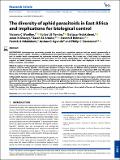| dc.description.abstract | BACKGROUND
Hymenopteran parasitoids provide key natural pest regulation services and are reared commercially as biological control agents. Therefore, understanding parasitoid community composition in natural populations is important to enable better management for optimized natural pest regulation. We carried out a field study to understand the parasitoid community associated with Aphis fabae on East African smallholder farms. Either common bean (Phaseolus vulgaris) or lablab (Lablab purpureus) sentinel plants were infested with Aphis fabae and deployed in 96 fields across Kenya, Tanzania, and Malawi.
RESULTS
A total of 463 parasitoids emerged from sentinel plants of which 424 were identified by mitochondrial cytochrome oxidase I (COI) barcoding. Aphidius colemani was abundant in Kenya, Tanzania and Malawi, while Lysiphlebus testaceipes was only present in Malawi. The identity of Aphidius colemani specimens were confirmed by sequencing LWRh and 16S genes and was selected for further genetic and population analyses. A total of 12 Aphidius colemani haplotypes were identified. Of these, nine were from our East African specimens and three from the Barcode of Life Database (BOLD).
CONCLUSION
Aphidius colemani and Lysiphlebus testaceipes are potential targets for conservation biological control in tropical smallholder agro-ecosystems. We hypothesize that high genetic diversity in East African populations of Aphidius colemani suggests that this species originated in East Africa and has spread globally due to its use as a biological control agent. These East African populations could have potential for use as strains in commercial biological control or to improve existing Aphidius colemani strains by selective breeding. | en_US |

